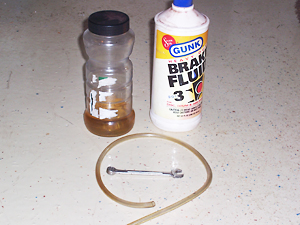Bob's no-nonsense instructions for
bleeding brakes
By Bob Westphal
 Over the last few months I have become more aware that a large number of people in the car hobby and in our club make a big deal out of bleeding the brakes on their cars. Also most people will allow expensive fluid to run onto the suspension and backing plate, which not only makes a mess but it can damage that precious paint they recently applied. Eventually the fluid drips onto the floor/ground which is environmentally a no! no!
Over the last few months I have become more aware that a large number of people in the car hobby and in our club make a big deal out of bleeding the brakes on their cars. Also most people will allow expensive fluid to run onto the suspension and backing plate, which not only makes a mess but it can damage that precious paint they recently applied. Eventually the fluid drips onto the floor/ground which is environmentally a no! no!
My son-in-law, who has been around cars for a long time, recently asked me to help him bleed his brakes. He was trying to use a hand operated vacuum pump for which he just paid $36. Before we were done with the first wheel he had hand cramps. Needless to say I taught him this easy process.
You don’t need to purchase expensive equipment such as a pressure bleeder or vacuum pump. Brake bleeding is really a very easy process that can be done all by yourself with minimal amount of very low cost tools. I have used this easy process for at least half a century most of time alone. Here is a list of tools you will need:
A piece of clear plastic tubing 18 - 24 inches long that fits snugly onto the bleeder nipple (about 3/16 ID). Cost maybe $2
A clear bottle that will hold at least a pint of fluid. Mayonnaise jars work well - cost - zip.
Here’s how it’s done. The process is easier with two people but like I said can easily be done by one person.
Pour about 1 1/2 to 2 inches of fluid in the bottle. Connect the tubing to the bleeder. Place the bottle of fluid on the floor/ground being careful so that it won’t tip over and stick the other end of the tubing into the bottle so that it goes to the bottom of the bottle. Crack open the bleeder. Get in the car and start pumping the brake peddle. The idea is to pump the pedal until there are no bubbles in the tubing. You will have to get out and check to see if the bubbles are gone a few times. When the bubbles are gone tighten the bleeder. Pour some of the fluid back into the master cylinder and move onto the next wheel. Since all the fluid you drain from the system is caught in the bottle, there will be minimal mess if any to clean up and you haven’t damaged the environment. I have never found any need to start bleeding on the wheel farthest from the master cylinder as you will remove all the air no matter what.
There is no need to pump the pedal until it is hard to push. If all the air is gone, the pedal will be hard. The reason this works is that no air can back into the system because the end of the tube is in fluid thus not allowing air back into the system. Only fluid will be drawn back into the lines.


